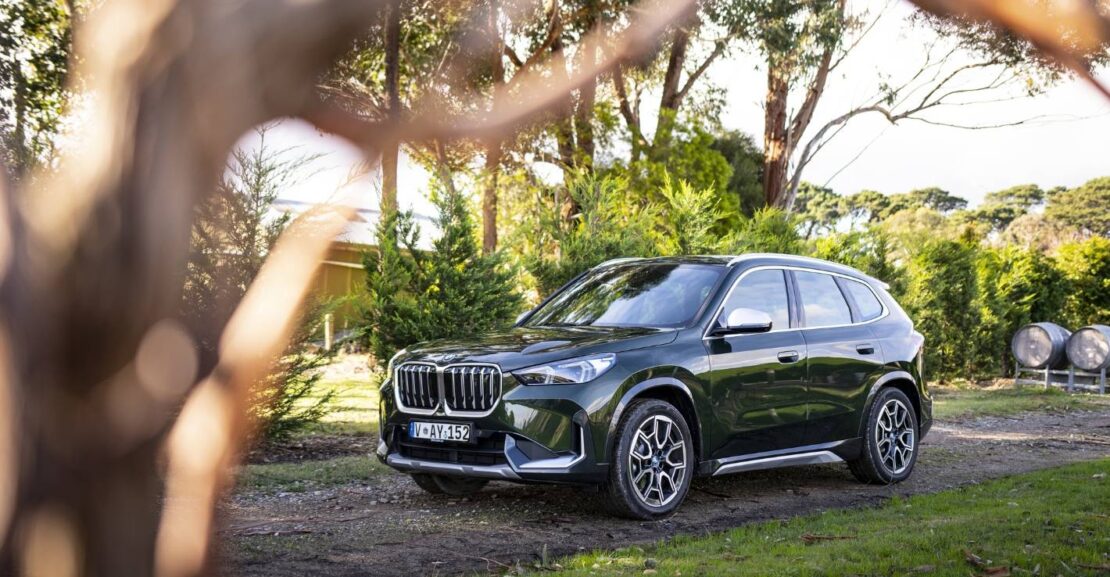[ad_1]
Matthew Hansen/Stuff
This is the BMW iX1 xLine, a spec that New Zealand misses out on.
The new entry point to BMW’s line-up of fully electric models, the iX1, has officially launched in Australia and New Zealand, with examples already appearing at local dealerships for customers to see in the metal.
Based on the same platform as the X1 and sharing an almost unchanged exterior and interior, the iX1 comes with a 65kWh battery pack (64.7kWh usable) and a 230kW/494Nm powertrain.
Its range is rated at 440km to a charge, with BMW claiming a combined average of 18.3kWh/100km is achievable. Stuff drove the iX1 for the first time late last week in Melbourne, with our first impressions embargoed until this coming Saturday.
Matthew Hansen/Stuff
The only iX1 destined for New Zealand at the minute is the xDrive30 with M-Sport trimmings, as pictured here.
New Zealand is set to only get one spec of iX1 at launch; the flagship, top-spec iX1 xDrive 30 with all-wheel drive and BMW’s M-Sport visual packages. It will retail for $96,900 plus on-road costs. That price includes a complementary home wall charger unit.
It’s a competitive price, with most of the iX1’s direct premium-brand models priced well above the $100,000 threshold. And, there is potential for that price to drop further.
Speaking at the iX1 launch, BMW Australia product planning manager Daniel Silverwood could not rule out the possibility of bringing in a more affordable two-wheel drive version of the iX1, priced to slot underneath the $80,000 Clean Car Discount threshold.
BMW has given the 5 Series a serious dose of high voltage.
“We would certainly be interested in that model if it were available. There would certainly be a market opportunity for that model. At this stage we can’t confirm whether there are any plans for the two-wheel drive version,” said Silverwood.
“There’s also a bit of a similar conversation in Australia, particularly about the price point and the luxury car tax threshold, which is increasing next week. There would certainly be a very large opportunity for that [2WD] version.”
So far, only one of the country’s premium manufacturers – Lexus – has been tempted to spec and sell an electric vehicle beneath the Clean Car threshold. Its UX300e was recently discounted, with the base model now priced from $79,900.
The iX1’s chief rivals, the Mercedes-Benz EQA and Audi Q4 e-tron start at $90,000 and $99,990 in their front-wheel drive formats, respectively. An all-wheel drive EQA is set to arrive later this year. Audi’s entry-level Quattro Q4, meanwhile, starts at $126,990.
Matthew Hansen/Stuff
The iX1 looks almost identical to its petrol-sipping X1 cousin. Note the badge and the blue trim around the BMW roundel.
Silverwood’s comments around availability likely point to a lack of supply of two-wheel drive iX1s outside of Europe. New Zealand’s reputation as a market that favours BMW’s high-spec models is also a potential reason behind the limited product mix.
BMW has previously been an advocate for raising the Clean Car Discount threshold higher. In its 2021 Land Transport Amendment Bill submission, the brand called for the government to lift the rebate threshold from $80,000 to $150,000.
In its 2021 submission, BMW said it was planning to launch three new EVs in New Zealand by 2025, and lifting the rebate threshold would lift that figure to five. Since the recommendation’s rejection, BMW has launched five new EVs in New Zealand, with a sixth (the i5) scheduled for the end of 2023.
[ad_2]
Source link
